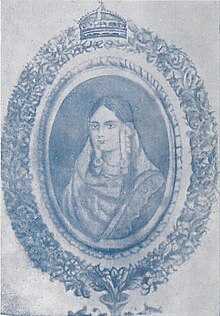| Amina Begum | |
|---|---|
| Nawabzadi of Bengal | |
 Portrait of Amina Begum from Banglar Begum (1912) | |
| Died | November 1760 Jahangirnagar, Bengal Subah (now Old Dhaka, Bangladesh) |
| Burial |
c. 1760 |
| Spouse | Zain ud-Din Ahmed Khan |
| Issue |
Ikram ud-Daulah Siraj ud-Daulah |
| House | Afshar (by birth) |
| Father | Nawab Alivardi Khan |
| Mother | Sharf-un-Nisa (sister of Sayyid Ahmed Najafi and daughter of Sayyid Hussain Najafi) |
| Religion | Shia Islam |
Amina Begum ( Bengali: আমিনা বেগম, Persian: امینه بیگم) was a Bengali aristocrat from the Nawab family of Bengal and mother of Siraj ud-Daulah, the last independent Nawab of Bengal. [1]
Early life and background
Amina Begum was the youngest daughter of Nawab Alivardi Khan, the Nawab of Bengal, and Princess Sharfunnisa, the paternal aunt of Mir Jafar. Her paternal grandfather was Mirza Muhammad Madani, who was of either Arab or Turkic descent, the son of a foster-brother of the Mughal emperor Aurangzeb. [2] [3] Her paternal grandmother belonged to the Turkic Afshar tribe of Khorasan. Through her, she was a relative of Shuja-ud-Din Muhammad Khan, the two having shared a common ancestor in Nawab Aqil Khan. [2] [4]
She married Zain ud-Din Ahmed Khan, who was appointed as the Naib Nazim (governor) of Patna by her father, Nawab Alivardi Khan. [5] They had two sons, Ikram ud-Daulah and Siraj ud-Daulah. [6]
Later life
In contrast to her elder sister Ghaseti Begum, Amina Begum was not very much involved in politics. In 1748, Amina was captured along with her two sons by the Afghan rebels of Mustafa Khan after they had killed her husband, Zain ud-Din Ahmed Khan, in an attempt to take control of Bihar. They were rescued by her father, Nawab Alivardi Khan, in 1751, who drove also drove out the Afghan rebels.
After the death of her father in 1756, her son Siraj succeeded the throne as the next Nawab of Bengal. Siraj was defeated by the British East India Company in the Battle of Plassey in 1757 partly due to the treachery of Amina's maternal cousin Mir Jafar. Amina Begum was subsequently imprisoned along with her other family members including her mother, sister, and daughter-in-law. They were exiled from Murshidabad on a boat travelling to Jahangirnagar (Dhaka) in 1758, and were kept confined in the Jinjira Palace. [6] [7]
Death

Mir Miran, the son of Mir Jafar, later ordered for some of them to be released and recalled back to Murshidabad in 1760. On their way from Dhaka by boat, Amina Begum died when her boat was sunk on the orders of Miran. [6] [8] She was buried beside her family in Khoshbagh, Murshidabad. [9]
References
- ^ Khan, Abdul Majed (2007). The Transition in Bengal, 1756–75: A Study of Saiyid Muhammad Reza Khan. Cambridge University Press. p. 20. ISBN 9780521049825.
- ^ a b Sarkar, Jadunath (1948). The History of Bengal. Vol. II. Dhaka: University of Dhaka. p. 436. ISBN 978-81-7646-239-6.
- ^ P. Sensarma (1977). The Military History of Bengal. Kolkata: Darbari Udjog. p. 172.
- ^ Subhan, Abdus (1970). "Early Career of Nawab Ali Vardi Khan of Bengal". Journal of Indian History. XLVIII (III). Trivandrum: University of Kerala: 536.
- ^ Chaudhury, Sushil (2016). Trade, Politics and Society: The Indian Milieu in the Early Modern Era. Taylor & Francis. p. 252. ISBN 9781351997287. Retrieved 6 November 2017.
- ^ a b c Karim, KM (2012). "Amina Begum". In Sirajul Islam; Miah, Sajahan; Khanam, Mahfuza; Ahmed, Sabbir (eds.). Banglapedia: the National Encyclopedia of Bangladesh (Online ed.). Dhaka, Bangladesh: Banglapedia Trust, Asiatic Society of Bangladesh. ISBN 984-32-0576-6. OCLC 52727562. OL 30677644M. Retrieved 27 April 2024.
- ^ "Jinjira Palace: A tale lost in time". Prothom Alo. Archived from the original on 7 November 2017. Retrieved 6 November 2017.
- ^ Sengupta, Nitish K. (2011). Land of Two Rivers: A History of Bengal from the Mahabharata to Mujib. Penguin Books India. p. 176. ISBN 9780143416784. Retrieved 6 November 2017.
- ^ "The Tombs of Murshidabad". The Daily Star. 8 March 2008. Retrieved 6 November 2017.